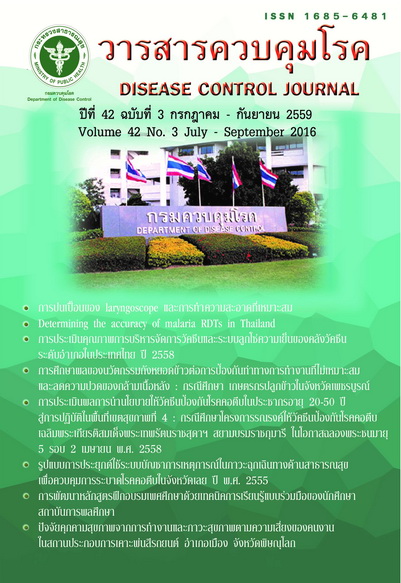Determining the accuracy of malaria RDTs in Thailand
DOI:
https://doi.org/10.14456/dcj.2016.12Keywords:
Rapid Diagnostic Test, RDT, accuracy, malariaAbstract
This study aimed to determine the accuracy of malaria rapid diagnostic tests (RDT) used in Thailand Malaria Control Program. Three brands of RDTs: Paracheck P.F.TM (detecting single species), OptiMAL ITTM and SD MRDT (detecting pan or multi-species), were field assessed and compared to Giemsa-Stained Thick Blood Film (GS-TBF). The assessment was conducted during April to July 2013 in the malaria clinics of three provinces, consisting a northern province; Tak, a western province; Kanchanaburi, and an eastern province; Chanthaburi. Totally 899 suspected malaria cases visited to these malaria clinics. Of these cases; 84, 157, and 658 found Plasmodium falciparum-positive, Plasmodium vivax-positive and malaria-negative, respectively. All cases were diagnosed by four tests; GS-TBF and the three RDT tests, consisting of Paracheck P.F.TM, OptiMAL ITTM and SD MRDT. These RDTs revealed the sensitivity for P. falciparum, 98.81%, 91.67%, and 94.05% respectively. Whereas the sensitivity for P. vivax of OptiMAL ITTM and SD MRDT were 94.27% and 95.54% respectively. The specificity of the three RDTs were higher than 99.00% which was proved that these RDTs were well discriminated for positive cases. This study revealed the superiority of Paracheck P.F.TM in detecting P. falciparum to two other RDTs. Regarding P. vivax, both OptiMAL ITTM and SD MRDT revealed their accuracy in bottom line of acceptance. In conclusion, this study gave evident to malaria policy maker to determine which kind of tests could be used in remote malaria endemic areas.
Downloads
References
2. Indaratna K, Kidson C. Changing economic challenges in malaria control. Southern Asian J Trop Med Public Health 1995;26:388-96.
3. Wongsrichanalai C. Rapid diagnostic techniques for malaria control. Trends Parasitol 2001;17 :307-9.
4. World Health Organization. Interim notes on selection of type of malaria rapid diagnostic test in relation to the occurrence of different parasite species, Guidance for national malaria control programmes, Prepared by Roll Back Malaria Department with the collaboration of the Regional Offices for Africa and the Western Pacific. Geneva: World Health Organization; 2005.
5. Palmer CJ, Lindo JF, Klaskala WI, Quesada JA, Kaminsky R, Ager AL. Evaluation of the Opti¬MAL test for rapid diagnosis of Plasmodium vivax and Plasmodium falciparum malaria. J Clin Microbiol 1998;36:203-6.
6. Piper R, Lebras J, Wentworth L, Hunt-Cooke A, Houz S, Chiodini P, et al. Immunocapture diagnostic assays for malaria using Plasmodium lactate dehydrogenase (pLDH). Am J Trop Med Hyg 1999;60:109-18.
7. Iqbal J, Hira PR, Sher A, Al-Enezi AA. Diagnosis of imported malaria by Plasmodium lactate dehydrogenase (pLDH) and histidine-rich protein 2 (Pf HRP-2) based immunocapture assays. Am J Trop Med Hyg 2001;64:20-3.
8. Cho-Min-Naing, Gatton ML. Performance appraisal of rapid on-site malaria diagnosis (ICT malaria Pf-Pv test) in relation to human resources at village level in Myanmar. Acta Tropica 2002; 81:13-9.
9. Wongsrichanalai C, Barcus MJ, Muth S, Sutami¬hardja A, Wernsdorfer WH. A Review of Malaria Diagnostic Tools: Microscopy and Rapid Diagnostic Test (RDT). Am J Trop Med Hyg 2007;77:119- 27.
10. Murray CK, Gasser RA Jr, Magill AJ, Miller RS. Update on rapid diagnostic testing for malaria. Clin Microbiol Rev 2008;21:97-110.
11. World Health Organization. Malaria rapid diagnostic test performance, results of WHO product testing of malaria RDTs: Round 2 (2008-2009). Geneva: World Health Organi¬zation; 2009.
12. World Health Organization. Basic malaria mi¬croscopy, part I: Learner’s guide, Second edi¬tion. Geneva: World Health Organization; 2010.
13. World Health Organization. Rapid Diagnostic Tests for Malaria, Document I, Method Manual for Laboratory Quality Control Testing, Regional Office for the Western Pacific, Version II, Gene¬va: World Health Organization; 2004.
14. World Health Organization. Malaria Microscopy Quality Assurance Manual Version I, Geneva: World Health Organization; 2009.
15. Muhamad P, Chaijaroenkul W, Congpuong K, Na-Bangchang K. SYBR Green I and TaqMan quantitative real-time polymerase chain reaction methods for the determination of amplification of Plasmodium falciparum multidrug resistance-1 gene (pfmdr1). J Parasitol 2011;97:939-42.
16. Food and Drug Administration. ICH, good clinical practice, standard operating procedures (SOPs). Bangkok: Drug Control Division, Food and Drug Administratio; 2000.
17. Ratsimbasoa A, Randriamanantena A, Raherin¬jafy R, Rasoarilalao, Menard D. Which malaria rapid test for Madagascar? Field and laboratory evaluation of three tests and expert microscopy of samples from suspected malaria patients in Madagascar. Am J Trop Med Hyg 2007;76:481-5.
18. USAID, Foundation for Innovative New Diagnostics (FIND), World Health Organization Western Pacific Regional Office (WHO WPRO), Roll Back Malaria Partnership, UNICEF. Transporting, Storing, and Handling Malaria Rapid Diagnostic Tests at Central and Peripheral Storage Facilities. Manila: WHO-WPRO; 2009.
19. Beadle C, Long GW, Weiss WR, McElroy PD, Maret SM, Oloo AJ, et al. Diagnosis of malaria by detection of Plasmodium falciparum HRP-2 antigen with a rapid dipstick antigen capture assay. Lancet 1994;343:564-8.
20. Garcia M, Kirimoama S, Marlborough D, Rieck¬mann KH. Immunochromatographic test for malaria diagnosis. Lancet 1996;347:1549.
21. Verle P, Binh LN, Lieu TT, Yen PT, Coosemano M. ParaSight-F test to diagnose malaria in hypo-endemic and epidemic prone regions of Vietnam. Trop Med Int Health 1996; 1:794-6.
22. Bureau of Vector Borne Diseases. The Global Fund to fight malaria round 7. Nonthaburi: Department of Disease Control, Ministry of Public Health Thailand; 2010.
Downloads
Published
How to Cite
Issue
Section
License
Articles published in the Disease Control Journal are considered as academic work, research or analysis of the personal opinion of the authors, not the opinion of the Thailand Department of Disease Control or editorial team. The authors must be responsible for their articles.






